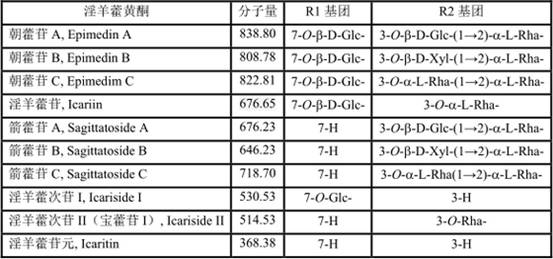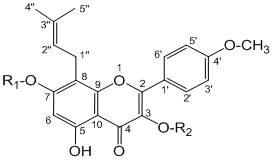Method for efficiently preparing anhydroicaritin through enzymatic conversion
An icariin and enzyme conversion technology, which is applied in biochemical equipment and methods, microorganism-based methods, microorganisms, etc., can solve the problems of undisclosed enzyme conversion, high industrialization cost, low reaction concentration, etc. Intermediate product, low cost, simple operation effect
- Summary
- Abstract
- Description
- Claims
- Application Information
AI Technical Summary
Problems solved by technology
Method used
Image
Examples
Embodiment 1
[0025] The method for efficiently preparing icariin by enzymatic conversion of the present invention is prepared according to the following steps:
[0026] a. Aspergillus [ Aspergullus sp.39g bacteria, reference: Dongming Wang (Wang Dongming) et al., ProcessBiochemistry 47 (2012) 133–138 pages] the bacteria were inoculated in 1000 ml of liquid medium containing 5% corn steep liquor and 1% epimedium powder medium, cultured with stirring at 29°C for 7 days to obtain a fermentation liquid, namely the original enzyme liquid;
[0027] b. Centrifuge the original enzyme solution to remove impurities and collect the supernatant, add 3 times the volume of methanol solution to the supernatant, overnight, and centrifuge to collect the enzyme protein precipitate; dissolve the enzyme protein precipitate in 1 / 10 volume of the original enzyme solution, 0.04M, pH5.0 citric acid buffer solution, centrifuged to remove impurities, to obtain Aspergillus organic solvent-resistant epimedium fla...
Embodiment 2
[0034] a. Preparation of Epimedium flavonoidase resistant to organic solvents: Aspergillus niger[ Aspergullus niger g.848, reference: Yongkun Xiao (Xiao Yongkun), etc., J. Ginseng Res. 43 (2019) 186-195 pages] bacteria were inoculated in 400 grams (dry matter) of solid medium containing 10% licorice stem and leaf powder, Cultivate at 30°C (with occasional stirring) for 8 days; then use 2000 ml of normal saline to extract the enzyme in the solid medium, separate the supernatant, and filter to obtain the filtrate, which is the original enzyme solution;
[0035] b. Centrifuge the original enzyme solution to remove impurities and collect the supernatant, add 3 times the volume concentration of 95% ethanol to the supernatant, overnight, and centrifuge to collect the enzyme protein precipitate; dissolve the enzyme protein precipitate in the original enzyme solution volume 1 / 5. In the phosphate buffer solution of 0.04M and pH5.0, centrifuge to remove impurities to obtain the orga...
Embodiment 3
[0041] a. Preparation of Epimedium flavonoidase resistant to organic solvents: Candida was inoculated in 400 g (dry matter) of wheat bran solid medium containing 15% Sophorae pollen, cultured at 30°C (stirring occasionally) for 8 days; then Use 2000 ml of 0.02 mol and pH=5.0 acetate buffer to extract the enzyme in the solid medium, separate the supernatant, and filter to obtain the filtrate, which is the original enzyme solution;
[0042] b. Centrifuge the original enzyme solution to remove impurities and collect the supernatant, add 3 times the volume of methanol to the supernatant, overnight, and centrifuge to collect the enzyme protein precipitate; dissolve the enzyme protein precipitate in 1 / 8 of the original enzyme solution volume, 0.04M , in the acetic acid buffer solution of pH 5.0, and centrifuged to remove impurities to obtain the organic solvent-resistant epimedium flavonoid glycoside enzyme solution of Candida fungus;
[0043] c. Mix 100 ml of organic solvent-resis...
PUM
 Login to View More
Login to View More Abstract
Description
Claims
Application Information
 Login to View More
Login to View More - R&D
- Intellectual Property
- Life Sciences
- Materials
- Tech Scout
- Unparalleled Data Quality
- Higher Quality Content
- 60% Fewer Hallucinations
Browse by: Latest US Patents, China's latest patents, Technical Efficacy Thesaurus, Application Domain, Technology Topic, Popular Technical Reports.
© 2025 PatSnap. All rights reserved.Legal|Privacy policy|Modern Slavery Act Transparency Statement|Sitemap|About US| Contact US: help@patsnap.com


